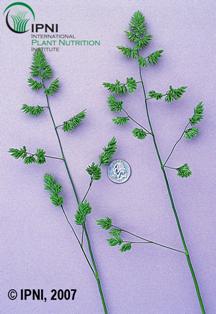Orchardgrass
Adaptation
- Short-lived grass that should only be planted north of Gainesville.
- Less tolerant of drought, poor drainage, and close grazing than tall fescue.
Establishment
Seed should be planted at 15 to 20 lb/A in September.
Varieties
- Benchmark
- Olympia
- Persist
- Endurance
- Persist
- Prairie
In Depth
 Orchardgrass is adapted to the more fertile soils in the Limestone Valley/Mountains Regions and some upper Piedmont sites. However, orchardgrass is not recommended for the lower Piedmont or Coastal Plain regions.
Orchardgrass is adapted to the more fertile soils in the Limestone Valley/Mountains Regions and some upper Piedmont sites. However, orchardgrass is not recommended for the lower Piedmont or Coastal Plain regions.
It is a bunch grass that produces an open sod and produces excellent quality forage. It is not as persistent as tall fescue. Even under ideal conditions, stands usually thin after 2 – 3 years and will need to be renovated. Though it can be grazed, orchardgrass stands will generally thin more rapidly in pastures. Orchardgrass stands are easier to maintain if they are cut for hay.
Mixtures of tall fescue and orchardgrass are widely used in hayfields in the upper Piedmont and Mountain regions (see photo below). Orchardgrass is also a great companion crop with a legume, such as red clover or alfalfa. A common use of orchardgrass is to seed it into alfalfa stands that have thinned.
Orchardgrass is best established on a prepared seedbed, though no-till establishment into an alfalfa or red clover stand will result in satisfactory results. Orchardgrass should be established in the fall. Plant 12 – 15 lbs of orchardgrass per acre when using a grain drill or sod seeding drill. When seed are broadcast and incorporated by disking or dragging, increase the seeding rate to 15 – 20 lbs per acre.

Orchardgrass hayfield in Bartow County.
Dr. Dennis Hancock
Forage Extension Specialist
Crop & Soil Sciences Dept.
